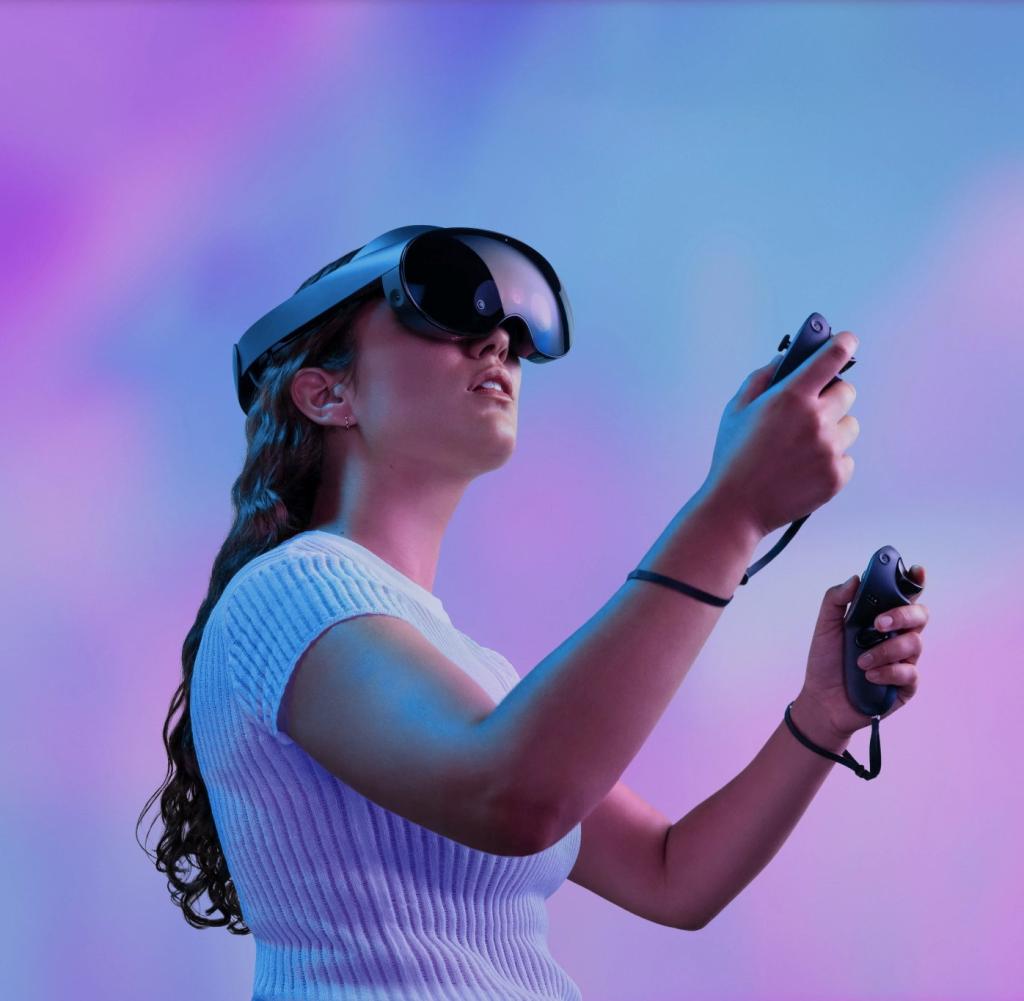Dhe iPhone company Apple presented its first virtual reality glasses on Monday evening – they are to be launched next year under the name “Apple Vision Pro”. It is the Group’s first fundamentally new device in almost ten years. Apple CEO Tim Cook called the glasses a “spatial computer” and compared the importance of the device to Apple with the introduction of the first personal computer in 1984 and the first iPhone in 2007.
“Your environment becomes an infinite canvas for content,” Cook explained the basic concept of the “Vision Pro”. Apple’s idea: The glasses should primarily become a work and communication device and transfer the programs and 2D content of the Apple product world into a three-dimensional, virtual space. This distinguishes Apple’s approach from that of the virtual reality pioneer Meta, which relies primarily on 3D games and interactive content with its Quest glasses.
Apple sees the “Vision Pro” as a computer that can stand on its own – it should fundamentally change how its users work, communicate or relax and watch movies. At the same time, Apple is trying to eliminate some of the fundamental problems of virtual reality by not cutting off the “Vision Pro” from the user’s environment.
5000 patents and the hope of a breakthrough for the technology
Apple’s developers are presenting some unusual solutions for operation and user involvement. They stated that they had been working on the device for years and that they had registered more than 5,000 patents for it. The presentation was somewhat reminiscent of the moment when Steve Jobs referred to the patents that protected the then new operating concept when presenting the iPhone in 2007. Also this time – as with the smartphone – Apple could manage to help a hitherto commercially unsuccessful technology to mass success.
Apple’s basic idea is to use the “Vision Pro” with twelve cameras, five motion sensors, six microphones and IR sensors integrate into the environment. Users should always be aware of their surroundings, and vice versa, the bystanders should continue to see the user.
For this, Apple not only built two stereoscopic displays into the glasses, but also designed the outside with a curved 3D screen under glass. The shape is a little reminiscent of oversized ski goggles through which the user’s face shines through. The eye movements on the outside of the screen correspond to the real viewing direction. Eye contact should be possible, even if the user is wearing the glasses. Apple also avoids ear-closing headphones, instead speakers are built into the strap of the glasses. On the outer screen, bystanders can see whether the user is watching media content or looking at their surroundings.
The displays in the glasses should display a total of 24 million pixels with such a fine resolution that the user can no longer perceive any pixel structures. Thanks to the cameras on the outside, he can either see his environment as it is in real life or merge a virtual environment and real surroundings, for example adding a virtual view of a nocturnal volcano to the real living room or completely hiding the apartment in favor of a virtual cinema.
Users will find everything from the Apple world in virtual reality
All content, apps and programs that users already know from their other Apple devices are also displayed in virtual reality, but the Apple designers have gone to great lengths to bring the usual program icons and windows into the third dimension transmitted, for example through shadows and 3D structure. In particular, work programs are implemented seamlessly, such as the complete Microsoft Office suite or collaboration programs such as teams, 3D-heavy design programs or Photoshop. Thanks to the high resolution of the displays, even fine fonts can be displayed without any problems, so fatigue-free work should be possible on huge virtual screens that are freely scalable and virtually hover in front of the user.
Apple also wants to have rethought the operation of virtual reality. Similar to the early 1980s with the mouse and the iPhone with multi-touch, Apple is not completely reinventing the user interface, but is combining existing technologies in a potentially revolutionary way. To operate their glasses, the developers rely on a combination of viewing angle tracking, speech recognition and 3D hand gestures, which are captured by special cameras on the lower edge of the glasses.
Users do not need any handheld controllers or wired devices, but can alternatively integrate the real keyboards and trackpads of their Mac computers into the virtual reality. A rotating crown, similar to that of the Apple Watch, allows basic 3D settings such as the zoom factor to be adjusted by hand. Using the photo button on the display frame, users can record their surroundings in three dimensions.
In general, the impression remains that Apple has brought together all of its development results and technologies from the past few years and put them into the glasses: the powerful M2 chip comes from the Macbook Pro, the sensors from the mobile devices, the crown from the Apple Watch, the image processing from the iPhones, the audio technology from the Airpods.
The software basis for the spatial operating system is a completely revised iOS, with the programmers attaching great importance to completely jerk-free display – Apple wants to avoid “motion sickness”, the nausea caused by virtual reality in sensitive users.
The glasses not only display content from the iPhone, such as 3D photos, in a new way, but can also accept all apps from the iOS universe and from the Mac. Users do not have to buy new content and programs first, they find a familiar environment in the VR world. This gives Apple a significant advantage over other providers. The “Apple Vision Pro” looks like a spectacular extension of the Apple world, the entire design communicates: Here comes something new – but the user will still be able to use it as easily as his iPhone or Mac.
At the same time, the Apple engineers have also thought about practical problems that have so far reduced the VR result of the competition: Instead of laboriously entering passwords, Apple simply installed an iris scanner called “OpticID”. Instead of tediously trying to make the glasses fit every head shape, Apple offers the so-called light apron, i.e. the cover around the eyes, and the headband in different sizes.
The batteries are banished from the glasses to the belt or in the trouser pocket to make the device as light as possible. They are also detachable and interchangeable from the cable, lasting two hours per charge. After all, Apple also takes care of the glasses wearers: together with the German optics specialist Zeiss, the group wants to offer interchangeable lenses that are adapted to the eyesight of the user.
In short, Apple has invested a lot of time and money to make the “pain points” around virtual reality go away. Tim Cook calls the “Vision Pro” the most advanced mobile device in the world. But the group wants to call a princely price for this. In the USA, the glasses are to be introduced in 2024 for $3499 net, before that, selected developer studios should be able to work with the devices to design suitable content.
The price should make the glasses a status symbol
In Europe, the gross price will probably be over 4000 euros, which would also make the glasses a status symbol. However, Apple has not yet given any details about the launch.
Facebook parent company Meta, completely geared towards virtual reality by founder Mark Zuckerberg for two years, chooses a different approach than Apple: Zuckerberg himself presented his new VR glasses Meta Quest 3 on Friday – deliberately before the Apple appointment, so that the glasses doesn’t get lost in Apple news. But the meta-product is aimed at a different target group: At 570 euros, the Quest 3 is significantly cheaper than Apple’s Vision Pro and suitable for the masses, and it is above all virtual reality glasses.
Cameras can still provide a view of the real world, which Meta calls “full-color passthrough”. Zuckerberg presented the idea of enabling interactions with digital objects such as game characters in a real environment. However, the bystanders cannot look at the user, Apple has the revolutionary idea of an external display that shows the user.
The quest is primarily aimed at computer gamers, even if Meta is currently trying to find applications beyond the gaming world. The built-in Snapdragon XR2 processor has enough power for complex 3D games and is said to work more than twice as fast as the hardware of the predecessor glasses Quest 2. The glasses are also lighter and narrower than the Quest 2. On September 27, Zuckerberg wants more details name and then also name a start date – probably before Apple.
“Everything on shares” is the daily stock exchange shot from the WELT business editorial team. Every morning from 7 a.m. with our financial journalists. For stock market experts and beginners. Subscribe to the podcast at Spotify, Apple Podcasts, Amazon Music and deezer. Or directly by RSS feed.




